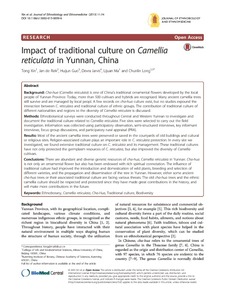Resource information
International License (http://creativecommons.org/licenses/by/4.0/), which permits unrestricted use, distribution, and
reproduction in any medium, provided you give appropriate credit to the original author(s) and the source, provide a link to
the Creative Commons license, and indicate if changes were made. The Creative Commons Public Domain Dedication waiver
(http://creativecommons.org/publicdomain/zero/1.0/) applies to the data made available in this article, unless otherwise stated.
Background: Cha-hua (Camellia reticulata) is one of China’s traditional ornamental flowers developed by the local people of Yunnan Province. Today, more than 500 cultivars and hybrids are recognized. Many ancient camellia trees still survive and are managed by local peopl. A few records on cha-hua culture exist, but no studies expound the interaction between C. reticulata and traditional culture of ethnic groups. The contribution of traditional culture of differ
Methods: Ethnobotanical surveys were conducted throughout Central and Western Yunnan to investigate and document the traditional culture related to Camellia reticulata. Five sites were selected to carry out the field
investigation. Information was collected using participatory observation, semi-structured interviews, key informant interviews, focus group discussions, and participatory rural appraisal (PRA).
Results: Most of the ancient camellia trees were preserved or saved in the courtyards of old buildings and cultural or religious sites. Religion-associated culture plays an important role in C. reticulata protection. In every site we investigated, we found extensive traditional culture on C. reticulata and its management. These traditional cultures have not only protected the germplasm resources of C. reticulata, but also improved the diversity of Camellia cultivars.
Conclusions: There are abundant and diverse genetic resources of cha-hua, Camellia reticulata in Yunnan. Cha-hua is not only an ornamental flower but also has been endowed with rich spiritual connotation. The influence of traditional culture had improved the introduction and domestication of wild plants, breeding and selection of different varieties, and the propagation and dissemination of the tree in Yunnan. However, either some ancient cha-hua trees or their associated traditional culture are facing various threats. The old cha-hua trees and the ethnic camellia culture should be respected and protected since they have made great contributions in the history, and will make more contributions in the future.


